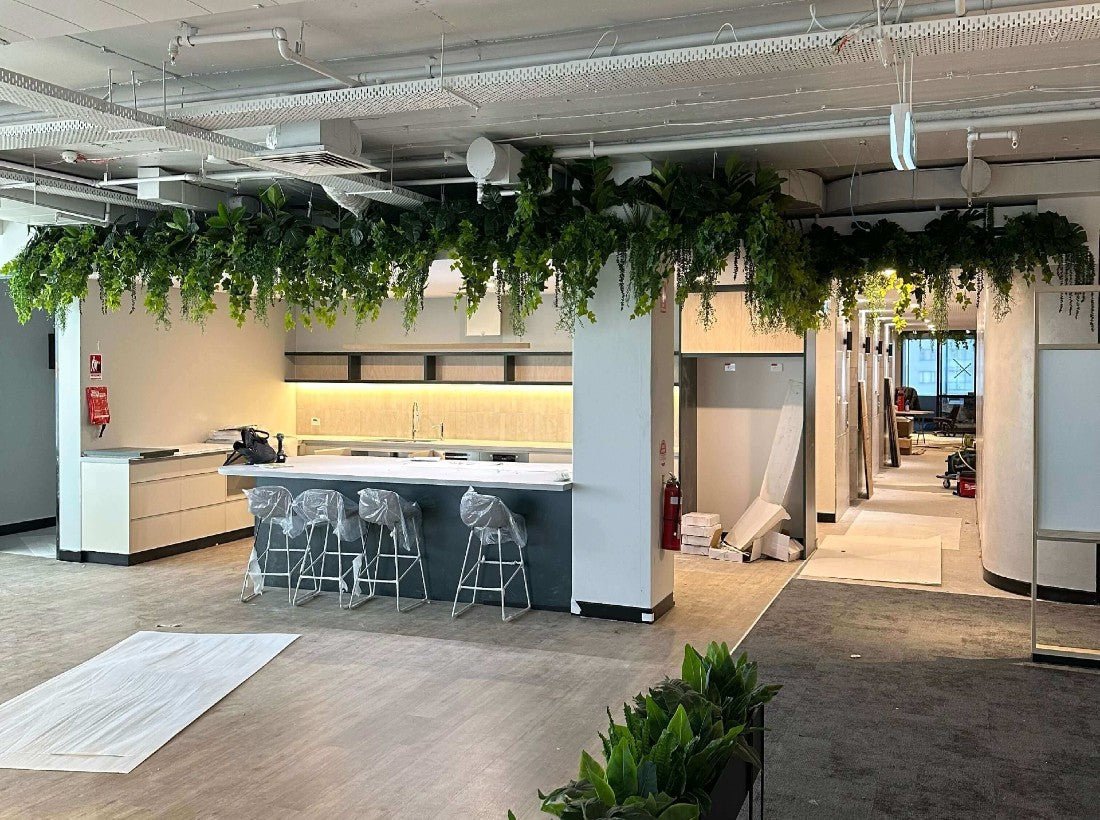With the state of the housing market nowadays, more and more people are choosing the alternate route - renting.
According to Self, about 34% of Americans rent their homes, translating to roughly 44 million rented housing units across the US.
But when you rent, you’re at the mercy of your landlord’s rules. Often, that means you’re stuck in spaces that may not reflect your style. Unfortunately, since the unit belongs to someone else, you can’t really decorate it according to your standards.
Permanent changes? Out of the question.
This limitation can cramp your style and make it difficult to show off your personality without stepping on your landlord’s toes.
Well, unless you know a few ways to go around it… legally, of course.
In this post, we’ll answer one question: how to hang plants from the ceiling without drilling so that your landlord doesn’t suspect a thing?
Strap in and let’s learn.
7 Renter-Friendly Ways to Hang Hanging Plants
Renting becomes a whole lot more enjoyable when you can add your personal touch. These tips will come in handy even if you’re a fledgling DIY-er and aren’t yet comfortable with a drill or other heavy tools.
So, here are 7 easy fixtures to help you learn how to hang a ceiling plant.
Adhesive Hooks
Adhesive hooks are the go-to solution for anyone looking to hang items without drilling holes and keeping the security deposit intact.
The no-trace removal is one of the most celebrated features of adhesive hooks. Plus, they usually come in sets and are relatively cheap at major retailers.
Still, it’s important to use the hooks correctly. First, test the hook on an inconspicuous area - ideally behind a piece of furniture that’s unlikely to move anytime soon. Apply the hook and then remove it to see if it damages the paint. If it does, you should reconsider your choice. If not, happy sticking!
When you’re ready to hang the plant, make sure the ceiling is clean and dry. Press the hook firmly for the recommended time and allow the adhesive to set before adding your plant. For heavier plants, use stronger adhesive options or multiple hooks to distribute the weight.
When you take the hooks down, be cautious. Any hasty attempts will send chunks of paint flying and will be a hassle to fix. If you find the hook stubborn, it might be best to leave it in place rather than risk a bigger mess. At worst, you can let your landlord know or cross your fingers they don’t notice after you’re gone (though we don’t recommend banking on that!).
Tension Rods

If you want an even more temporary solution, hang your plants on tension rods. These rods use pressure to stay in place between two walls, which is strong enough to hold hanging decorations in place.
One of the major benefits of tension rods is their ease of use in that they’re easy to reposition or remove without damaging the walls. Still, we suggest using them for more lightweight plants, preferably faux ones. The reason for this is that even if the rod slips and your plants tumble, they won’t break or make a mess like real plants, which could spill soil everywhere.
It’s also important not to overload the rod with too many plants. We know it’s hard to resist, but overloading can weaken the tension and cause the rod to lose its grip. After all, the point is to keep your plants hanging, not falling.
Alternatively, you can use smaller tension rods right by the windows to avoid straining them.
Suction Hooks

Provided you have the right surfaces, suction hooks might be one of your best options (if not the best). These hooks attach to non-porous surfaces like tiles, glass, or metal. So, if you have any exposed pipes or metal beams, this is the way to hang pots from the ceiling.
Unfortunately, they don’t work well on drywall or other similar materials, so you might need to explore other options if that’s all you have to work with.
As with tension rods, it’s important to keep your plants lightweight. Heavier plants can cause the suction to give way and yank you out of bed in the middle of the night.
Here’s how to use them effectively:
- Clean and dry the surface because dust and moisture can weaken the suction
- Press the hook firmly against the surface to create a strong seal
- Space the faux plants equally and avoid clustering them all together
Curtain Rods
If your apartment has a built-in curtain rod, you’re already halfway to your display. Swap out the attached curtain for a string of hanging plants that create a new green curtain.
Grab some S hooks and space them out evenly along the rod. Remember to exercise caution because the same considerations apply here - don’t overload. Too many plants can cause it to lose stability.

Try mixing a variety of hanging plants, trailing vines, or even small hanging baskets to make the display more dynamic. Stagger them to avoid a flat, cut-off look and create a flowing effect that looks natural.
A green curtain idea is a renter-friendly and innovative way to use up all the vertical space at your disposal and use hanging plants more practically.
Clothing Rack
If you have the space for a clothing rack, you should ditch all other options, especially if you’re after stability.
Since clothing racks are made to hold clothes, they’re built tough and their construction supports any other hanging item, including plants. So, if you have a large and weighty plant like our faux Fern Ball, this setup is ideal.
Another perk with using clothing racks as hanging surfaces is that they’re easy to find and come cheap. You can pick one up at IKEA or order from Amazon, but if you’re thrifting, check out Goodwill or even Facebook Marketplace.
If you’re into DIY, you can turn this into a fun upcycling project. Buy a plain and dull rack, give it a makeover, and turn it into a centerpiece that turns heads and fits your interior like a glove.
Magnetic Hooks

If you haven’t taken advantage of magnetic hooks - what are you doing?
These hooks are a renter’s dream for hanging plants because they leave no trace when removed and require zero drilling or adhesives. Sadly, they come with a small caveat - you need a metal surface to attach them to, as they don’t work on drywall or wood.
If you’ve got metal beams, exposed pipes, or metal fixtures above eye level, magnetic hooks are a fantastic choice. They don’t leave marks, you can rearrange or remove them without worry, and your landlord will be none the wiser.
What’s more, these hooks are strong and reliable for both lighter and heavier plants. You just need to attach them to the surface and hang your favorite faux hanging basket. Rest assured, your ceiling will remain unscathed.
Coat Stands
Let’s end by thinking outside the box for a second.
If you have a coat stand gathering dust, give it a new lease on life and use it to hang plants. This is a creative, unconventional way to bring hanging plants into your space without damaging walls or ceilings.
During the warmer months, when your coats and scarves snuggle in the closet, repurpose your stand, place it in a corner, and use the hooks to hang plants. Not only is this a clever way to use up vertical space, but the stand itself is a unique decorative element that already suits your space.
And lest we forget the mobility. You can move your plants around to adjust the layout or catch better light without being tied down to a fixed spot.
If your stand has multiple levels of hooks or bars, you can even create a layered display and use different types of faux hanging plants like Artificial Hanging Pearls, Faux Philodendron, and a wispy Fake Fern.
Finishing Thoughts
As you can see, there’s no shortage of creative, renter-friendly ways to hang your plants without causing damage to your rental.
We showed you 7 ways to protect your deposit, but trust that there are many more options you can try out. The key takeaway is to consider the weight and placement of your display and take precautions to avoid giving your landlord a tension headache.
So, now that you know how to hang plants from the ceiling without drilling, you can help your own indoor display shine damage-free.


